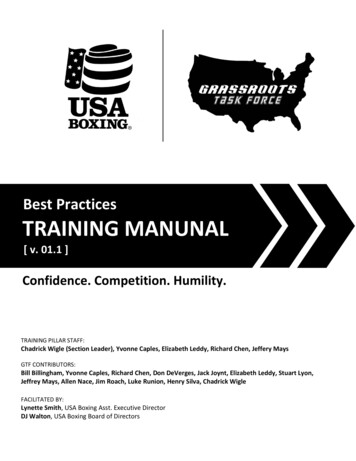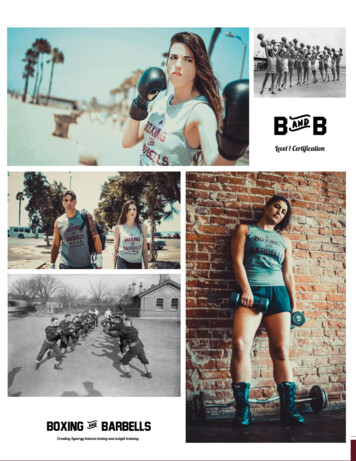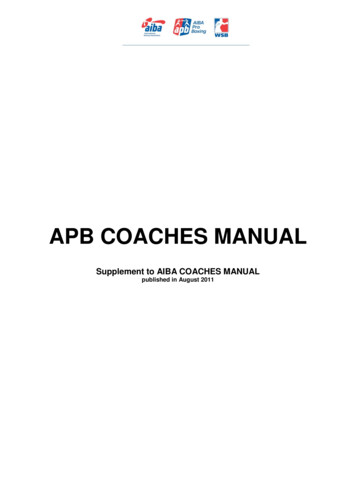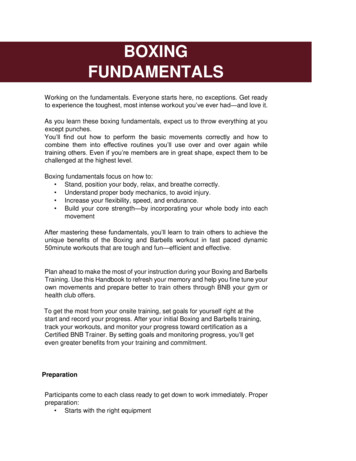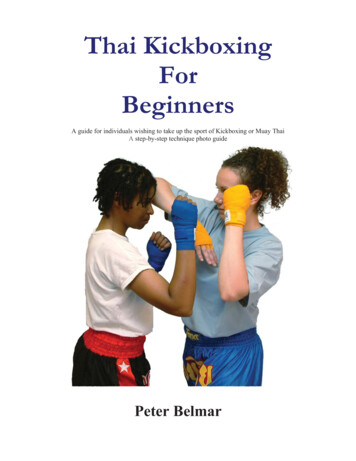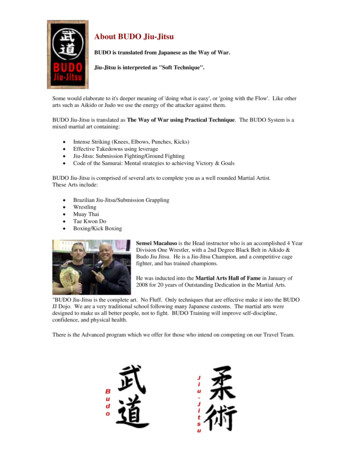
Transcription
Boxing1
BoxingAbout the TutorialBoxing requires a lot of self-discipline, high tolerance level, courage, and uniquedefensive expertise. This tutorial explains the fundamentals of boxing, such as when itall began, moves and strategies, information on basic boxing gear, and the types ofboxing. It also provides information on the various tournaments held along with a list ofthe legends of the game.The information here is meant to supplement your knowledge on the sport. However, itis not a comprehensive guide on how to play the sport.AudienceThis tutorial is meant for anyone who wants to know about boxing. It is preparedkeeping in mind that the reader is unaware about the basics of the sport. It is a basicguide to help a beginner understand the sport of boxing.PrerequisitesBefore proceeding with this tutorial, you are required to have a passion for the sport andan eagerness to acquire knowledge on the same.Copyright & Disclaimer Copyright 2015 by Tutorials Point (I) Pvt. Ltd.All the content and graphics published in this e-book are the property of Tutorials Point(I) Pvt. Ltd. The user of this e-book is prohibited to reuse, retain, copy, distribute, orrepublish any contents or a part of contents of this e-book in any manner without writtenconsent of the publisher.We strive to update the contents of our website and tutorials as timely and as preciselyas possible, however, the contents may contain inaccuracies or errors. Tutorials Point (I)Pvt. Ltd. provides no guarantee regarding the accuracy, timeliness, or completeness ofour website or its contents including this tutorial. If you discover any errors on ourwebsite or in this tutorial, please notify us at contact@tutorialspoint.com2
BoxingTable of ContentsAbout the Tutorial .2Audience.2Prerequisites .2Copyright & Disclaimer .2Table of Contents .31. BOXING – OVERVIEW . 5Objective .5Boxing – A Singles Sport .52. BOXING – PARTICIPATING COUNTRIES . 63. BOXING – PLAYING ENVIRONMENT. 7Boxing Ring Design.7Dimensions of a Boxing Ring .74. BOXING – EQUIPMENT . 95. POPULAR TERMS IN BOXING. 106. BOXING – HOW TO PLAY? . 12Getting Ready . 12Quick Glimpse of the Game. 12Scoring . 13Fouls . 137. BOXING – VARIANTS . 15Amateur boxing . 15Professional boxing . 158. BOXING – TOURNAMENTS . 17Amateur boxing tournaments . 173
BoxingProfessional boxing tournaments . 179. BOXING – CHAMPIONS . 184
1. BOXING – OVERVIEWBoxingBoxing, also known as the art of self-defense or pugilism (fist fight), is one of the mostpopular sports today. Its origins are tracked back 4000 years BC in North Africa. There isalso evidence of it being played in Greece and Rome. Over the years, it developed intobeing the sport it is today. Boxing not only requires a high level of athleticism, vitalityand strength, but also a high level of concentration and endurance.ObjectiveA boxing match is held in a square ring, with two corners marked with red and blue colorbelonging to the fighters’ teams, where under the supervision of a judge and acommission, two athletes compete using fair fighting techniques under a set of rules.The basic objective of boxing is knocking down the opponent using a combination oftechniques, under the supervision of a judge and a commission and following a set ofrules. Reading further, you will get to know the essentials of boxing, the rules, as well ashow it’s played and the current champions in the arena.Boxing – A Singles SportBoxing is a singles sport, meaning it’s a competition between two individuals. It’s playedboth in men’s and women’s category.5
2. BOXING – PARTICIPATING COUNTRIESBoxingAlthough originating from North Africa, boxing has become a worldwide sport, followedby many fans in every continent. Its biggest fan base is in America and Europe.In the early days, boxing was illegal in USA, but after the State of New York legalized itin 1896, the other states followed. The main body of boxing is the American BoxingAssociation (ABA), which organizes tournaments and awards championship belts.America has produced and still produces many of the biggest names in boxing, such asMuhammad Ali and Mike Tyson.The biggest rival of America in boxing competitions is, of course, Europe. The EuropeanBoxing Union, known to fans as EBU, oversees the development of boxing in thecontinent, and also implements the rules.6
3. BOXING – PLAYING ENVIRONMENTBoxingBefore every match, each boxer is given a corner, the red or the blue, where his team isstationed and they meet between rounds.Boxing Ring DesignThe term “ring” has its origin from the early boxing fights, where a circle was drawn atthe spot in which the match was held.A boxing ring is the space in which a boxing match is held. A modern ring, is set on araised platform, it is square with a post at each corner to which four parallel rows ofropes are attached with a turnbuckle. Two of the corners are colored red and blue,belonging to a respective player. Unlike the wrestling ring, the boxing ring ropes areconnected together between the posts. The floor of the ring must have around 1 inch(25mm) of padding covered with canvas.Dimensions of a Boxing RingThe size of the boxing ring may vary depending on the type of tournament and relevantgoverning body. The standard ring is between 16 and 25 feet (4.9 and 7.6 m) to a sidebetween the ropes with another 2 feet (0.61 m) outside. The platform of the ring isgenerally 3 to 4 feet (0.91 to 1.22 m) from the ground with the posts rising around 5feet (1.5 m).7
BoxingThe ropes are around 1 inch (25 mm) in diameter and held up on posts rising around 5feet (1.5 m) at heights of 18, 30, 42, and 55 inches (.46, .76, 1.07, and 1.37 m).8
4. BOXING – EQUIPMENTBoxingApart from the ring, boxers should have the following basic equipment in order tocompete:Gloves – This is the most important piece of equipment for boxers. It’s used toprotect the wrists and hands of the boxers, as well as to protect the face of theopponent from incoming blows.Mouthpiece – It has to be worn in order to protect the mouth and teeth, as well asto absorb some of the force of the blows to the head.Headgear – It’s mandatory only for amateur boxers to protect their head.Protective cups are to be worn on every competitive level, to shield the groin area.Boxing professionals have to wear loose-fitting trunks and soft-soled shoesacross all the levels of the game.Sleeveless jersey at amateur level, boxers are required to wear a sleeveless jerseyof a different color than the waistband of the trunks.9
5. POPULAR TERMS IN BOXINGBoxingBefore being able to play or watch boxing, you should be familiar with the followingterms, which are most frequently used during boxing matches.Blocking: The technique to prevent an opponent's punch from landing cleanly on thehead or torso by using the hands, shoulders or arms.Bout: A short spanned match conducted between two competitors with a timeline offour three-minute rounds, and with a break of one-minute between each round.Break: A referee's command for boxers to free from a prolonged trap or a clinch.Caution: An admonition to the boxer by a referee. Three cautions are issued beforea warning. Mostly, the player is cautioned when he commits a foul.Clinch: When two boxers are holding, or trapping each other for a longer duration,without any punches or fight involved.Down: A boxer is considered "down" if he touches the floor with anything other thanhis feet or if he goes outside the ropes after receiving a punch. A boxer is alsotechnically "down," even if he hasn't fallen but takes a serious blow or blows to thehead and the referee steps in to stop the action.Foul: An infringement of boxing rules.Hook: A short power punch in which the boxer swings from the shoulder with hiselbow bent, bringing his fist from the side toward the center.In-fighting: Boxing at close range.Jab: A quick, straight punch thrown with the lead hand.Knock Down: A boxer is technically "knocked down," even if he hasn't fallen but hetakes a serious blow or blows to the head and the referee steps in to stop the action.Neutral Corner: One of the two corners in the ring that do not belong to eitherfighter.Rabbit Punch: This punch is considered to be against the game rules or as beingillegal, as one of the competitors lodges a punch to the back of the opponent’s heador body (mostly kidneys). This punch is mostly delivered when the boxers are havinga wrestle “inside”.Saved by the Bell: When a fighter is on the verge of being knocked out, or isknocked out just as the bell sounds, so that the fighter does not lose and has aminute to compose himself.Standing 8 Count: This term is used when one of the boxers is unable to continuethe fight due to reasons like being injured, cannot continue, etc. In this case, the10
Boxingreferee stops the fight and starts a count till eight, giving the player a chance toeither continue or declare closure.Uppercut: This is one of the punches that is landed on the guard of the boxer frombelow in an upward direction.Warning: An alert given by the referee to the boxer in case of any fouls or extensionof three warnings. Once the referee indicates a warning then the ringside judges willdecide about issuing points. The opponent who is issued the warning, loses the boutor is disqualified.Weaving: A method used by the boxer to escape the anticipated punches throughtwist and turn movements.11
6. BOXING – HOW TO PLAY?BoxingThe objective of boxing, as mentioned before, is to knock out the opponent, making himunable to stand until the referee counts to ten. Another way of winning in boxing, is byscoring points.Getting ReadyBefore every match, there are a few steps that needs to be completed:1. Passbook check – A passbook is the identification of a boxer, and it is required tobe shown before every competition. It documents your weight, information aboutyour opponents and results of the matches played.2. Weigh-in – This is required in order to be placed in the fitting weight category.3. Physical examination – After the weigh-on a physician examines the capability ofa boxer to compete. The things they check consist of: Blood pressure Breathing Condition of hands and face4. Wrap check – Usually the judge signs the wraps, meaning the boxer has followedthe given procedures and rules. After the signing, the boxer is sent to the host, whogives the boxer either red or blue gloves, depending on the assigned corner.5. As the boxers get into the ring, and sit on their assigned posts, the judge comes tomake a final check if the boxers are wearing a mouthpiece and the correct size ofgloves.6. The boxers are introduced, and called in the center of the ring where they touchgloves, a sign of sportsmanship.7. The boxers return to their corners and wait for the bell to ring to mark the beginningof the fight.Quick Glimpse of the GameThe players have to fight a series of rounds (normally 12) with one-three minutesintervals. A bell is rung to signify the start of each round.There is a wooden table placed at the ringside, and a ring official hits it with ahammer, to denote that there are only ten seconds left in each round.A boxer is declared winner, when the opponent is down and does not resume withinten counts or when the player is seriously injured.Winner of the game is declared through scoring, onlydisqualification or any knock-outs.when there is no12
BoxingScoringWho won the round is mostly based on counting "scoring punches" - punches withthe knuckle side of the fists that strike the front or sides of the opponent's body(above the belt) or head. Fouls are also tracked and affect scoring. According to thejudges, these may be: the number of punches, aggression put in, control of the ring,controlling the fight tempo, and the amount of damage caused.Scoring in professional boxing is quite different from scoring at the amateur level. It’sbased on four criteria: Clean punchingEffective aggressivenessRing generalshipDefenseThe scoring system maintained by the judges is the 10-point-must system. Ina closed round, the winner of each round is issued 10 points, whereas thedefeated boxer will receive 9 points. Similarly, the loser will receive 8 points ifknocked down or taken over. Seven points if knock-out was twice. Bothboxers will receive 10 points each when the round is even.A boxer is declared the winner when all the three judges are in accordanceand when the boxer receives more points than the opponent. If the majorityof judges declare the match tie, then the match is called for a draw.A match can be concluded by four possible decisions of the judges:1. Unanimous decision: Here all the judges are in agreement and score the boxersame and declare as the winner.2. Split decision: Here, two of the three judges support one boxer, and the otherone, supports the other boxer.3. Majority decision: One judge draws the match, whereas the two other judgesscore one boxer.4. Draw: This happens, when none of the judges are in agreement. One judgescores for one boxer, another judge for another boxer, and the third judge evensout the match. In this state, none of the boxers is declared the winner.FoulsA foul committed by a player results in the deduction of points by the judges.Committing a serious foul or committing a foul repeatedly, can result in disqualification.To prevent the fight from becoming a brawl and prevent severe injuries boxers mustnot: Strike below the beltStrike when the opponent boxer is down on the canvasKickStrike with elbows, forearms or the inside of the hand (slap)13
Boxing Head-buttBite earsGrab onto the ropesPoke the eye with a thumbWrestle, grapple or hold the opponent excessively14
7. BOXING – VARIANTSBoxingBoxing is played at two levels: Amateur (Olympic) and Professional boxingAmateur boxingAmateur boxing takes place at many events, such as the Olympic Games, Pan AmericanGames and Commonwealth Games. The bouts are short in duration compared toprofessional bouts and fighters must wear protective headgear. For this reason, thewinner is decided by scoring punches, meaning, when boxers connect with the knuckleportion of the gloves. Every punch that is landed either on the head or the torso of theboxer is considered as a point. The judge monitors the fight to make sure that only legalpunches are dealt.Professional boxingProfessional boxing is also called prizefighting. It originated in the early 20th century,when boxing was legalized and started to be a regulated sport. The bouts last longerthan in amateur boxing, with more number of rounds, depending on the significance ofthe fight.15
BoxingProtective gear is not allowed, and the boxers can take up much more damage thanamateur fighters, before the judge halts the fight. Although it seems more brutal,professional fights are enjoyed much more than amateur fights.16
8. BOXING – TOURNAMENTSBoxingBecause of its huge popularity, different organizations organize boxing tournaments at aprofessional or amateur level.Amateur boxing tournaments Golden Gloves Association of America – This association organizestournaments in different states, the winners of each different state compete at anational level (The Golden Gloves Tournament of Champions) to decide thewinner. Mexico also organizes a tournament called Guantes De Oro (meaning “Gloves ofGold”) USA Boxing – A non-profit organization that promotes Olympic-style boxing inAmerica. It is overseen by the United States Olympic Committee, and its rules areset by the International Boxing Association.Professional boxing tournaments World Boxing Association (WBA) - An international boxing organization thatawards the WBA world championship title. World Boxing Council (WBC) – One of the most prestigious organizations forboxing. It has over 140 countries with their flags represented on the awardingbelt. World Boxing Organization (WBO) – The organization which recognizesprofessional boxing world champions. International Boxing Federation (IBF) – The federation creates differentregional titles throughout the United States and other countries, to give youngboxers the opportunity to participate.17
9. BOXING – CHAMPIONSBoxingBoxing tournaments are held in different categories, depending on the weight of thecompetitors. Following are some of the legends of the sport.Muhammad Ali, the American professional boxer is oneof the most renowned heavyweight champion in sportshistory. He reserves the record of being the only one tohave won the lineal World Heavyweight Championshiptitle three times, in 1964, 1974, and 1978. He wonseveral historic boxing titles and hence earned thenickname “Greatest”. His unprecedented grace andunique style made him a legend and Sports Illustrateddeclared him to be the "Sportsman of the Century".Mike Tyson, often referred to as ‘Kid Dynamite’ isconsidered as one of the best heavyweight champions ofall time and has an impressive list of accomplishments tohis credit. He holds the record of being the youngestboxer to have won the World Boxing Council, ation heavyweight titles at 20 years, 4 months, and22 days old.Henry Jackson Jr., known as Henry Armstrong isregarded as one of the greatest boxers of all time. He notonly belonged to the group of boxers who won boxingchampionships in three or more different divisions (therewere only eight universally recognized World titles at thetime) but also has the record of holding three worldchampionship titles (featherweight, lightweight, andwelterweight) at a time in 1938. Armstrong successfullydefended his welterweight title 19 times and was knownfor his style of throwing punches from all angles.18
BoxingHerbert Lewis Hardwick, the Afro Puerto Rican boxer,was inducted into the hall of fame in 2012. He primarilyfought middleweight and welterweight matches. Hardwick,who was well known by his nickname “Cocao Kid” won theWorld Colored Championships in both these divisions.Joseph William Calzaghe, the former Ring SuperMiddleweight and light heavyweight champion, is thelongest reigning super middleweight champion, having heldthe title for more than 10 years. He successfully defendedthe title 21 times, however, finally relinquished it move upto the light heavyweight division. In 2009, The RingMagazine ranked him Number 3 in the world.Rocky Marciano, is said to be the only boxer to haveheld the heavyweight title without a bout tie or defeatthroughout his career. Marciano was famous for his castiron chin and incredible endurance power. Known for hisferocious punches, he holds the highest knockoutpercentage of 87.75.Floyd Joy Mayweather Jr., is best known as theundefeated professional five division world champion.Mayweather has 11 world titles to his credit, and has wonthe lineal championship in four different weightcategories. He topped the list of the 50 highest paidathletes by Forbes and Sports Illustrated for the year2012, 2013 and 2014.19
BoxingManny Pacquiao, the Filipino boxer is the first and the onlyeight-division world champion. Pacquiao, is a three-timewinner of the ‘The Ring’ and ‘BWAA’ Fighter of the Yearaward having won in the year 2006, 2008, and 2009. TheBoxing Writers Association of America, World BoxingCouncil, and World Boxing Organization endowed him withthe title “Fighter of the Decade” for the 2000s. Forbesranked him as the second highest paid athlete in the worldin 2015.20
Boxing is a singles sport, meaning it’s a competition between two individuals. It’s played both in men’s and women’s category. 1. BOXING – OVERVIEW . Boxing 6 Although originating from North Africa, boxing has become a worldwide sport, followed by many fans in every continent. Its biggest fan base is in America and Europe.
